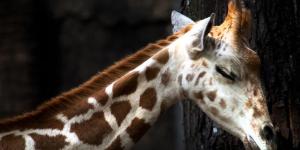What Color Is a Giraffe’s Tongue and Why?


With their towering height, graceful gait, and distinctively patterned coats, giraffes (Giraffa) stand out as one of nature's most awe-inspiring marvels. As the tallest land animals on Earth, giraffes possess a unique and elegant beauty that sets them apart from all others. They primarily feed on leaves, buds, and shoots from trees and bushes. Their long necks and prehensile tongues allow them to access vegetation that is out of reach for other herbivores.
In the following AnimalWised article, we explain everything you need to know about giraffe's tongues, their size, color, and other amazing facts about these animals.
What is special about a giraffe's tongue?
The giraffe (Giraffa), a ruminant animal, is a strict herbivore that sustains itself on a diet consisting primarily of leaves, flowers, seeds, and fruits. While it exhibits a certain degree of dietary diversity, it displays a particular fondness for acacias, relishing their succulent foliage.
Moreover, the giraffe capitalizes on the presence of mineral-rich soils by directly licking them, thereby supplementing its nutritional requirements.
As a ruminant, the giraffe possesses a complex digestive system, characterized by the division of its stomach into four chambers. This intricate structure optimizes nutrient absorption, aided by the remarkable behavior of rumination—repeatedly chewing the cud, even while in motion between different locations.
Intriguingly, upon comparing the digestive organs of giraffes with those of other ruminants, certain disparities become evident. The giraffe's rumen and omasum, for instance, are relatively smaller or less developed, setting them apart from their ruminant counterparts.
One noteworthy attribute of the giraffe is its tongue, which corresponds proportionally to its impressive size—long and slender. This remarkable organ resides within its snout, characterized by its narrowness, and extends to rest upon its highly flexible upper lips. This unique adaptation allows the giraffe to effortlessly pluck leaves from the uppermost branches of trees, which remain inaccessible to most other herbivores.
Delving into the specifics of the giraffe's tongue, we can highlight a few distinctive features. Firstly, the presence of a pronounced bulge on the upper part, anatomically referred to as the "lingual torus," while the sides exhibit corresponding depressions known as "fossa linguae."
The giraffe's tongue also houses salivary glands, actively contributing to the production of saliva. This crucial substance initiates the breakdown of food by mixing with specialized enzymes while engaging with the vegetation.
Unlike their bovine counterparts such as cows and bulls, the giraffe boasts a significantly more mobile tongue. This enhanced mobility stems from its deeper insertion into the genioglossus muscle, affording the giraffe greater protraction—allowing its tongue to extend remarkably beyond its mouth. This characteristic enables the giraffe to retrieve food more efficiently, even from thorny plants, without causing harm to itself.
Despite the giraffe's captivating attributes, comprehensive studies on the detailed anatomy of its mouth are limited. The available data primarily stems from captive specimens, which undergo alterations due to differences in their captive diet compared to the diverse range of plants available in their natural habitats. Consequently, our knowledge of the giraffe's tongue remains somewhat rudimentary, with only generalized information currently at our disposal.

Why color is a giraffe's tongue?
Indeed, the giraffe's tongue has a unique and intriguing coloration. It is dark in hue, often described as purple, bluish, or nearly black. However, it's important to note that the dark color is predominantly visible in the portion of the tongue that protrudes from the mouth, specifically the front area. As you move toward the center and inner parts of the oral cavity, the color gradually lightens, taking on a pinkish tone.
The dark coloration of the giraffe's tongue can be attributed to the presence of a pigment called melanin. Melanin is responsible for producing various hues in tissues, including the skin and tongue. Depending on the combinations and concentrations of melanin, different coloration can be observed.
One plausible explanation for the giraffe's dark tongue color is its adaptation to the environments in which it resides. Giraffes typically inhabit areas with intense solar radiation, such as savannahs, open forests, and arid regions.
Since giraffes are constantly on the move and frequently extend their tongues to feed, the dark coloration of their tongues may serve as a protective mechanism against sunburn caused by prolonged exposure to the sun.
This hypothesis suggests that the melanin-rich tongue provides some degree of natural sun protection. However, it's important to note that further scientific studies are needed to confirm this theory and provide a definitive explanation for the dark coloration of the giraffe's tongue.
We invite you to explore another article where we uncover the reasons behind the giraffe's extraordinary long neck.
How long is the giraffe's tongue?
The giraffe's tongue, proportionate to its size, is not only strong but also impressively long. It measures around 45 to 50 cm (17.7 to 19.7 inches), with slight variations among individuals.
Thanks to its muscular tongue, the giraffe can effortlessly grasp vegetation, even those adorned with thorns, found in the treetops. This remarkable adaptation allows it to reach and consume its favorite plant, the acacia, known for its thorny nature.
Interested in giraffes? Make sure to read our other article, where we answer whether they sleep standing up.

Other characteristics of the giraffe's tongue
Now that we have explored the size and main anatomical characteristics of the giraffe's tongue, let's delve into some interesting facts about this organ and its mouth in general:
- The giraffe's tongue is not only long but also incredibly flexible. It can extend far beyond its mouth, allowing the giraffe to reach vegetation located high up in the trees.
- The tongue is covered in a thick, slimy mucus that protects it from thorns and rough foliage. This mucus also helps prevent the tongue from drying out in arid environments.
- Giraffes use their tongues not only for feeding but also for grooming. They use their tongues to clean their ears and even their own eyes, providing hygiene and comfort.
- The tongue of a giraffe is incredibly strong. It can strip leaves off branches with precision, even plucking thorny plants without causing harm to the mouth.
- Despite its size, the giraffe's tongue is surprisingly delicate. It can delicately manipulate leaves and extract them from tight spaces, demonstrating remarkable dexterity.
- Giraffes have an acute sense of taste, thanks to numerous taste buds on their tongues. This allows them to discern between different types of vegetation and select their preferred food sources.
- Giraffes use their tongues to communicate with each other. During interactions, they often touch and intertwine their tongues, which is believed to be a form of social bonding and affection.
Don't forget to check out our other article, where we delve into the fascinating realm of giraffe communication.
If you want to read similar articles to What Color Is a Giraffe’s Tongue and Why?, we recommend you visit our Facts about the animal kingdom category.
- Maisano, S. (2006). Giraffa camelopardalis . Animal Diversity Web. Available at: https://animaldiversity.org/accounts/Giraffa_camelopardalis/
- Perez, W.; Michel, V.; Jerbi, H. & Vazquez, b. Anatomy of the mouth of the giraffe ( giraffa camelopardalis rothschildi ). int. j. morphol., 30(1):322-329, 2012. Available at: https://scielo.conicyt.cl/pdf/ijmorphol/v30n1/art57.pdf







